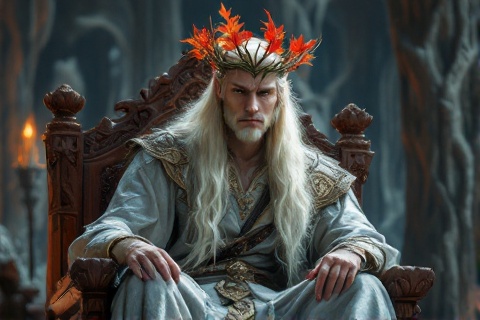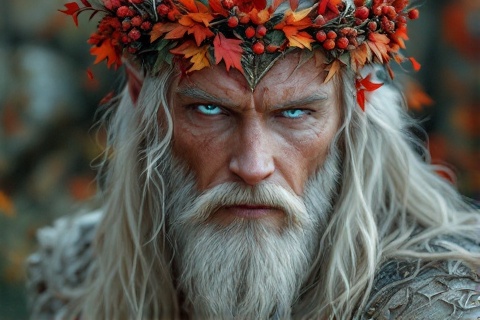
Thranduil
The Elvenking of the Woodland Realm
Origin and Identity
Thranduil was among the noble Sindar elves who journeyed
eastward across the Misty Mountains following the tumultuous events of the
First Age, seeking new lands to call home after the
destruction of Beleriand. His people were drawn to the vast
greenwood that would later be known as Mirkwood, finding in
its ancient trees an echo of their former woodland homes.
As the son of Oropher, Thranduil was raised to understand the responsibilities
of leadership from an early age. When Oropher established the Woodland Realm in
Greenwood the Great during the Second Age, he created a
kingdom that would blend Sindarin customs with a new way of life adapted to the
wild forests of the east. After Oropher's death in the War of the Last Alliance,
Thranduil succeeded him as king, carrying forward his father's legacy while
developing his own style of leadership.
Under Thranduil's guidance, the Woodland Realm flourished in the northern
regions of Greenwood the Great. He chose this location strategically,
establishing his people's presence among the ancient beeches and oaks that
reminded many of the great forests of old. The settlement grew steadily as
Thranduil's leadership brought stability and prosperity to the region, though
they would face many challenges as the forest slowly darkened over the
centuries.
The Woodland Realm

The heart of Thranduil's kingdom lay within a network of magnificent underground
halls in northeastern Mirkwood, carved into a great hill and protected by magic
and strong gates. These caves served as both a fortress and a palace, providing
security for his people while maintaining the beauty and comfort befitting an
elven realm.
The design of Thranduil's halls was inspired by the legendary caves of Menegroth
in Doriath, where many of the Sindarin elves, including
Thranduil's own people, had once dwelled. The halls featured intricate stone
pillars carved to resemble trees, with torchlight reflecting off polished
surfaces and streams of clean water flowing through the living rock. This
architectural marvel combined natural beauty with defensive capability, creating
a haven that would endure for ages.
Throughout the Third Age, Thranduil's realm remained one of
the few stable elven kingdoms in
Middle-earth, standing strong while many other elven
realms diminished or were abandoned. The king maintained his people's culture
and strength even as other elven populations decreased across Middle-earth,
preserving their ways in the face of changing times.
As darkness crept into Greenwood the Great, transforming it into Mirkwood,
Thranduil's leadership became crucial for his people's survival. He established
careful patrols and protective enchantments around his realm, creating a safe
haven within the increasingly dangerous forest. His warriors kept watch against
the spiders, orcs, and other fell creatures that began to infest
the southern portions of the wood, ensuring his people remained secure within
their protected borders.
Physical Appearance and Character

Thranduil cut an impressive figure among his people, standing tall with the
bearing of an ancient lord of the Sindar. His long fair hair caught the light
like strands of gold, and his presence commanded immediate respect from all who
encountered him. His physical appearance reflected the nobility of his lineage
and the power he wielded as king of the Woodland Realm.
The Elvenking was known for his distinctive crown, which changed with the
seasons of the woodland realm. In spring, it might be adorned with woodland
flowers and new leaves, while in autumn it would feature red berries and golden
leaves. This tradition connected him symbolically to the forest he ruled and
demonstrated the deep bond between the Woodland elves and their natural
environment.
Those who encountered Thranduil could not help but notice the ancient wisdom in
his eyes and the noble air that surrounded him. His countenance bore the weight
of centuries of experience, yet retained the ageless quality characteristic of
the Eldar. His bearing reflected both the glory of the elder days and the
practical wisdom gained from ruling a realm in the wild lands of the east.
Leadership Style
Thranduil's approach to governance was marked by a strong protective instinct
toward his realm and people. He maintained strict isolation from the troubles of
the outside world when possible, focusing his resources and attention on
preserving the safety and prosperity of his own kingdom rather than involving
himself in the broader conflicts of Middle-earth.
The well-being and flourishing of his subjects remained Thranduil's highest
priority throughout his reign. He ensured his people had everything they needed
to maintain their way of life, from securing trade routes for necessary goods to
protecting the forests that sustained them. This focus on his own realm's
prosperity sometimes led others to view him as insular, but his people benefited
greatly from his dedicated leadership.
Though proud and sometimes stern, Thranduil was known for rendering fair
judgments in matters brought before his throne. He balanced justice with mercy,
as demonstrated in his treatment of Thorin's company, whom he imprisoned for
trespassing but treated well and would have eventually released. His decisions
were guided by a deep understanding of both law and circumstance.
The borders of the Woodland Realm were carefully monitored under Thranduil's
rule, with strict controls over who could enter or pass through his territory.
This vigilance was necessary given the growing dangers in Mirkwood, but it also
reflected his belief that the safety of his realm depended on careful regulation
of outside influences.
Military Prowess

The Battle of Five Armies marked a crucial
moment in Thranduil's reign, where he led his forces with tactical skill and
courage. His army of well-trained warriors proved instrumental in the conflict,
demonstrating the military might of the Woodland Realm. The battle tested not
only his leadership in warfare but also his ability to forge alliances in times
of great need.
Thranduil maintained a formidable military force throughout his reign, with
warriors skilled in both forest warfare and traditional combat. His soldiers
were expert archers and swordsmen, equipped with weapons and armor that
reflected their woodland heritage while maintaining the high quality expected of
elven craftsmanship.
During the War of the Ring, Thranduil's realm faced repeated attacks from
Sauron's forces, as the Dark Lord sought to destroy all who
opposed him in the north. Through skillful leadership and the valor of his
warriors, Thranduil successfully defended his kingdom against these assaults.
His forces even managed to win a great victory against the armies that assailed
them, though the details of these battles are less well-known than other events
of the war.
Relationships with Other Races
The relationship between Thranduil and the dwarves of Erebor
was marked by centuries of tension and occasional cooperation. Historic
grievances, including disputes over treasure and ancient insults, created a
foundation of mistrust that persisted even through periods of necessary
alliance. Despite these challenges, Thranduil maintained diplomatic relations
when required, though always with careful consideration of his realm's
interests.
The men of Lake-town proved more amenable trading partners for Thranduil's
people, with a mutually beneficial relationship developing over many years. The
Woodland Realm traded wine and other goods with the lake-men, who
in turn provided necessary supplies that couldn't be produced within the forest.
This partnership helped maintain the prosperity of both peoples.
Thranduil's cautious approach to outsiders entering his realm was well-known
throughout the region. Travelers who ventured into his territory without
permission were typically detained and questioned, regardless of their status or
intentions. This policy, while strict, helped maintain the security of his
kingdom in an increasingly dangerous world.
Legacy and Influence

Throughout the Third Age, Thranduil's realm served as a beacon of elven culture
in Middle-earth, preserving ancient customs and knowledge while many other elven
settlements diminished. His people maintained their traditions and arts, keeping
alive the songs, crafts, and wisdom of their ancestors even as the world changed
around them.
Following the Battle of Five Armies, Thranduil played a significant role in
establishing a lasting peace in the northern regions. His diplomatic efforts
helped forge stronger relationships between the various peoples of the area,
contributing to a period of relative stability and prosperity that benefited all
the free peoples of the north.
As the father of Legolas, Thranduil raised a son who would later play a crucial
role in the War of the Ring as a member of the
Fellowship. While Thranduil himself remained
focused on protecting his realm, his son's participation in the greater events
of Middle-earth demonstrated how the Woodland Realm's influence extended beyond
its borders in unexpected ways.
With the dawn of the Fourth Age and the diminishing of elven
power in Middle-earth, Thranduil eventually joined the great westward migration
of his people. Along with many of the Woodland elves, he departed over the sea
to the Undying Lands, leaving behind a legacy of
steadfast leadership and careful stewardship of his realm through some of
Middle-earth's darkest days.
